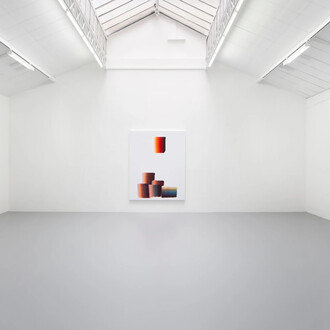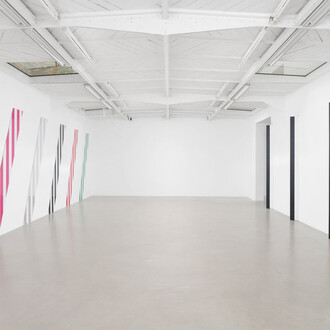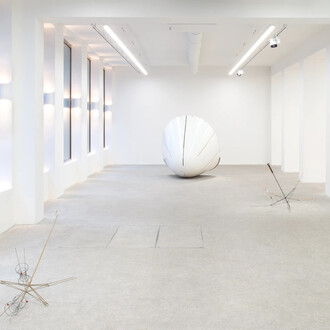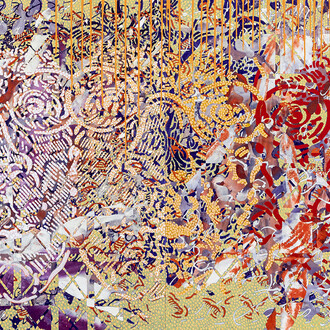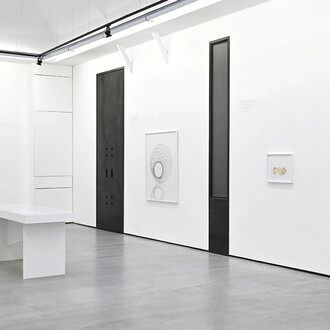To celebrate the opening of a new gallery space at number 5 Rue du Pont de Lodi in Paris, Kamel Mennour is pleased to present Simultanément travaux in situ et en mouvement, the first joint exhibition of two major French and international artists: Daniel Buren and Philippe Parreno.
"Quantum physics tells us that what is true for numbers is not necessarily true for objects. One object plus another object does not always equal two objects. If exhibiting is also a matter of exposing oneself—the artists have decided to do this together. There is an underlying notion of assembly, of sympoesis: two assembled works that have been formed together, connected to one another, to produce something relating to an automaton.
The exhibition investigates the way things appear and disappear, which is what defines a ghost or indeed any form that manifests itself. When medieval scribes remembered having already read a sentence they were in the midst of transcribing, they called this feeling a ghost. The ghost was this rereading. It represents the uncertain, the unfinished, but also the reinvented. Such quasi-objects have an unfinished existence. The world is not only haunted by ghosts, it is constantly transformed by them. There’s no way to escape them. No object exists without its exhibition; it responds to a new story or a new mise-en-scéne, it appears in a new ritual. The relationship between (artistic) determination and (contextual) heteronomy is at the heart of our works, which within their own language explores this relationship in order to make it visible.
There is a suspension of the borders between things, space, and our interventions. The place in which a work develops, in this case a gallery space, becomes an integral part of the work itself, which is situated in a constant back-and-forth between the site and its artistic transformation.
The same topological problem presents itself if one wants to produce an effective galvanic cell, which requires raising the percentage of electrolytes in a restricted volume. It is not possible to see a space in a single instant; it has to be traversed. It is more a matter of a linear voyage that folds in upon itself in Riemannian space.
How does a form appear? How is it possible for something like that to appear? To investigate the conditions of possibility in art means talking about the “existence” of a form, of its presence. It has to breathe, for there must be breath if the form is to take form and the place to take place. This is the ecstatic dimension of everything that appears and disappears, that flees from its own body to become an event rather than an object.
The space opens and closes to the rhythm of a form that is also trying to exist, to appear within a gaze, to manifest itself. A space undergoing the time of its own unveiling. A stochastic space, one given up to chance, made up of glimmers and events. Everything is breath and movement in this place, that is never really a place, since it is endlessly forming and deforming itself. To answer the question posed by the apparition of a form in a sense means talking about rhythm.
Every exhibition becomes by the same token an articulation of the breath, a labour of breathing."
(Philippe Parreno)
![Daniel Buren – Philippe Parreno « Simultanément, travaux in situ et en mouvement », kamel mennour [5 rue du Pont de Lodi], Paris, 2020
© Daniel Buren, Adagp
© Philippe Parreno
Photo. archives kamel mennour
Courtesy of the artists and kamel mennour, Paris/London](http://media.meer.com/attachments/e514c6980e7aed681c796b23dfd5d1c38bd7a3b3/store/fill/1090/613/03043a06868ee3d5f6a984b04b39d53e3c90e33a04c8d37db29faf24a639/Daniel-Buren-Philippe-Parreno-Simultanement-travaux-in-situ-et-en-mouvement-kamel-mennour-5-rue.jpg)

![Daniel Buren – Philippe Parreno « Simultanément, travaux in situ et en mouvement », kamel mennour [5 rue du Pont de Lodi], Paris, 2020
© Daniel Buren, Adagp
© Philippe Parreno
Photo. archives kamel mennour
Courtesy of the artists and kamel mennour, Paris/London](http://media.meer.com/attachments/642f75b5ffeb366fdfcf5b8edc296f963f2a949a/store/fill/410/308/4728dc5c23b261a7676d0810894820cdd330801441d6e91fb02ba437a39f/Daniel-Buren-Philippe-Parreno-Simultanement-travaux-in-situ-et-en-mouvement-kamel-mennour-5-rue.jpg)
![Daniel Buren – Philippe Parreno « Simultanément, travaux in situ et en mouvement », kamel mennour [5 rue du Pont de Lodi], Paris, 2020
© Daniel Buren, Adagp
© Philippe Parreno
Photo. archives kamel mennour
Courtesy of the artists and kamel mennour, Paris/London](http://media.meer.com/attachments/e9645c1c469886ad1f17b94e8cc50486867f4fdc/store/fill/410/308/e0746590dc53d2a7f132e4bd37269aad5bf43c618f7e723cd80eea55126f/Daniel-Buren-Philippe-Parreno-Simultanement-travaux-in-situ-et-en-mouvement-kamel-mennour-5-rue.jpg)
![Daniel Buren – Philippe Parreno « Simultanément, travaux in situ et en mouvement », kamel mennour [5 rue du Pont de Lodi], Paris, 2020
© Daniel Buren, Adagp
© Philippe Parreno
Photo. archives kamel mennour
Courtesy of the artists and kamel mennour, Paris/London](http://media.meer.com/attachments/fc60d6208b5d79257958111f63182d9882134ef0/store/fill/410/308/11bcf2f963a85a4a9159c4d5a1f8627cfb15bca30f02ca0450855b3c288c/Daniel-Buren-Philippe-Parreno-Simultanement-travaux-in-situ-et-en-mouvement-kamel-mennour-5-rue.jpg)
